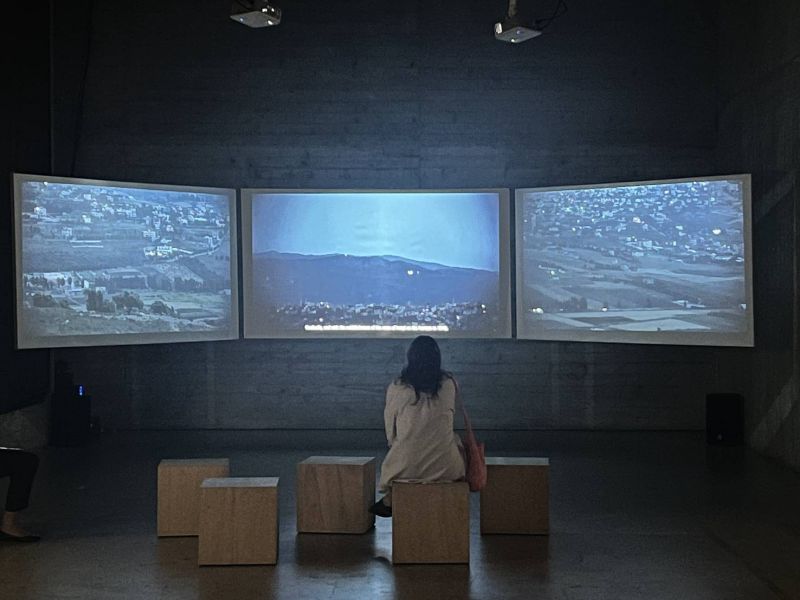
The centerpiece of "The Bunker, The Barracks and The Base" is a short three-channel essay film on Khiam and its British imperial traces today. (Courtesy of: Mina Image Centre)
BEIRUT — “The project actually started with my grandmother,” Batoul Faour says. “I had no idea this place existed. I was driving past one day and all you can see now is this metal cone peeking from the ruins left by the air strikes. I asked my grandmother, ‘What is that?’
“‘Oh,’ she said, ‘those are the underground rooms we used to play in as kids. They’re so dark, you’d go in and get lost. There was a whole maze, and we’d try and find our way out the other end.’
“When I went to visit the site for the first time, I found kids playing there, the ones featured in [my] film, and something came full circle in my mind. I started digging into the history.”
Faour is recalling how she stumbled into “The Bunker, The Barracks, and The Base,” her mixed-media exhibition now up at Mina Image Centre in Beirut. Her Lebanon debut, the show is concerned with the titular structures she encountered in Khiam. Overlooking the border with Palestine, the southern village has witnessed plenty of history.
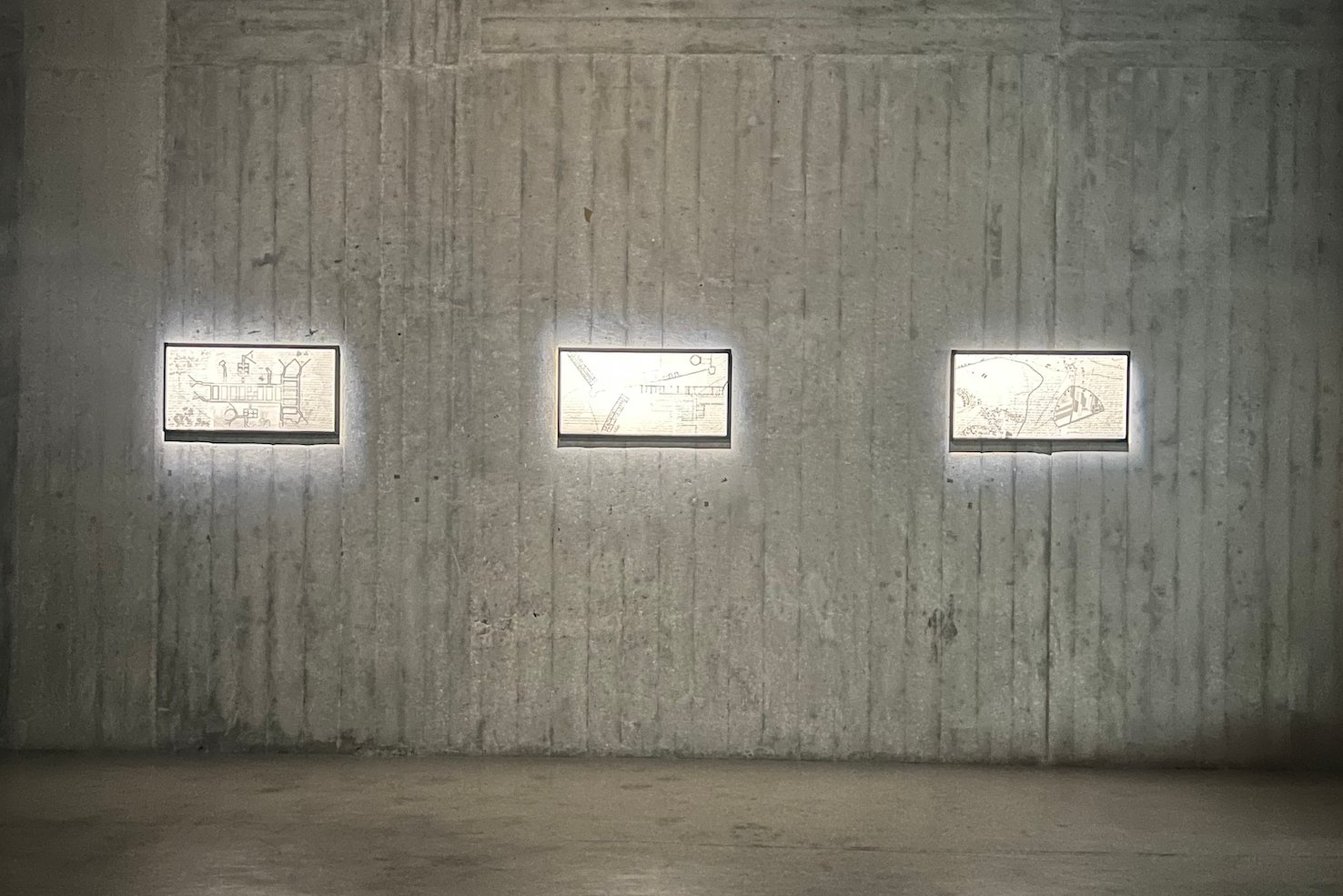 Another series superimposes architectural drafts of the facility’s three sites over the diary entries of Khiam resident Ibrahim Basbous. (Courtesy of: Mina Image Centre)
Another series superimposes architectural drafts of the facility’s three sites over the diary entries of Khiam resident Ibrahim Basbous. (Courtesy of: Mina Image Centre)
Architecture, history, contemporary art
“The Bunker, The Barracks, and The Base” fixes its gaze on a moment from Britain’s imperial presence in the region. The artifacts Faour found in the Marjayoun-Khiam valley were built as part of the so-called “Merdjayoun Scheme”’ London’s plan to defend its interests in the neighborhood. In the early 1940s, Nazi-allied Vichy administered France’s mandates in Syria-Lebanon. Worried that German forces would attack mandatory Palestine and British-occupied Egypt, imperial forces (Australians, Indians, British, some Free French) invaded Syrian-Lebanon in 1941.
The “Merdjayoun Scheme” dates from 1942 — though Vichy forces had been defeated by the summer of 1941, after which Free French forces ran Syria-Lebanon.
The centerpiece of Faour’s show is an untitled 18-minute, three-channel video installation. Shot in the manner of an essay film, it documents the lingering traces of its titular structures while the characters’ voiceover, in-frame commentary and Faour’s inter-title narration sketch the ruins’ origins and changing roles in this turf’s conflict-laden history.
Children once again play at the bunker that had been a hospital. What remains of the barracks are nowadays a museum. Erected for a planned airstrip, the stone foundations of an unfinished aircraft hangar adorn rich agricultural land and pasture.
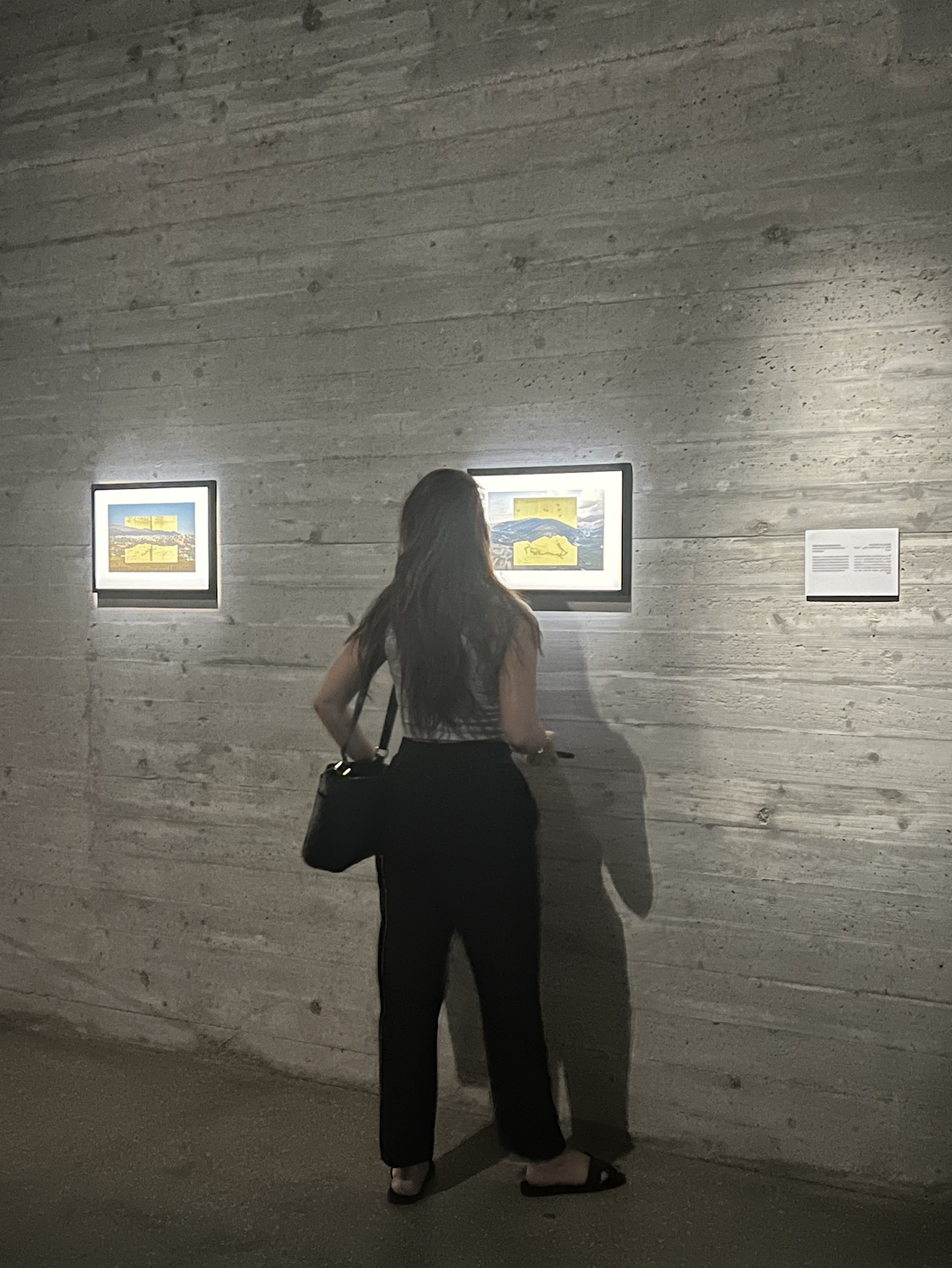 One series features works that collage digital photos of contemporary Khiam with archival landscape sketches. (Courtesy of: Mina Image Centre)
One series features works that collage digital photos of contemporary Khiam with archival landscape sketches. (Courtesy of: Mina Image Centre)
Supporting the video installation are three series of mixed-media images, juxtaposing contemporary and historic representations of the architectural relics and their surrounding landscape.
One series centers on contemporary landscape photos showing villages that sustained heavy bombing during the 34-day Hezbollah-Israel war in 2006, with digital distortion signifying structural damage. The photos’ horizon lines are superimposed upon those of “visibility diagrams” — landscape sketches of these locations, rendered from the same perspective by British army draftsmen in 1942.
Another series is based on architectural drafts of the facility’s three sites, with the sketches’ lines thinner to signify which parts of the structures were destroyed in 2006. The drafts are superimposed over the diary entries of Khiam resident Ibrahim Basbous, a customs officer who facilitated the sites’ construction.
“Basbous writes about the British looting of artifacts from the mountains around Khiam and Marjayoun,” Faour says. “They knew what they were looking for. He explains that they came with a map of the area’s significant historical sites. They sealed off these sites, so other people couldn’t enter, and came out with jugs and vases and whatnot.”
The largest of Faour’s framed pieces is a collage based on a map of the “Merdjayoun Scheme,” sketching the network of survey stations, surveillance posts and gun emplacements British army engineers were meant to install in the Khiam-Marjayoun region. Highlighting the facilities’ three components, the map is superimposed upon a contemporary satellite image of the region.
Accompanying the collage is a series of photos showing rows of massive stone cubes, further traces of the Scheme, installed to hinder the progress of fascist tanks.
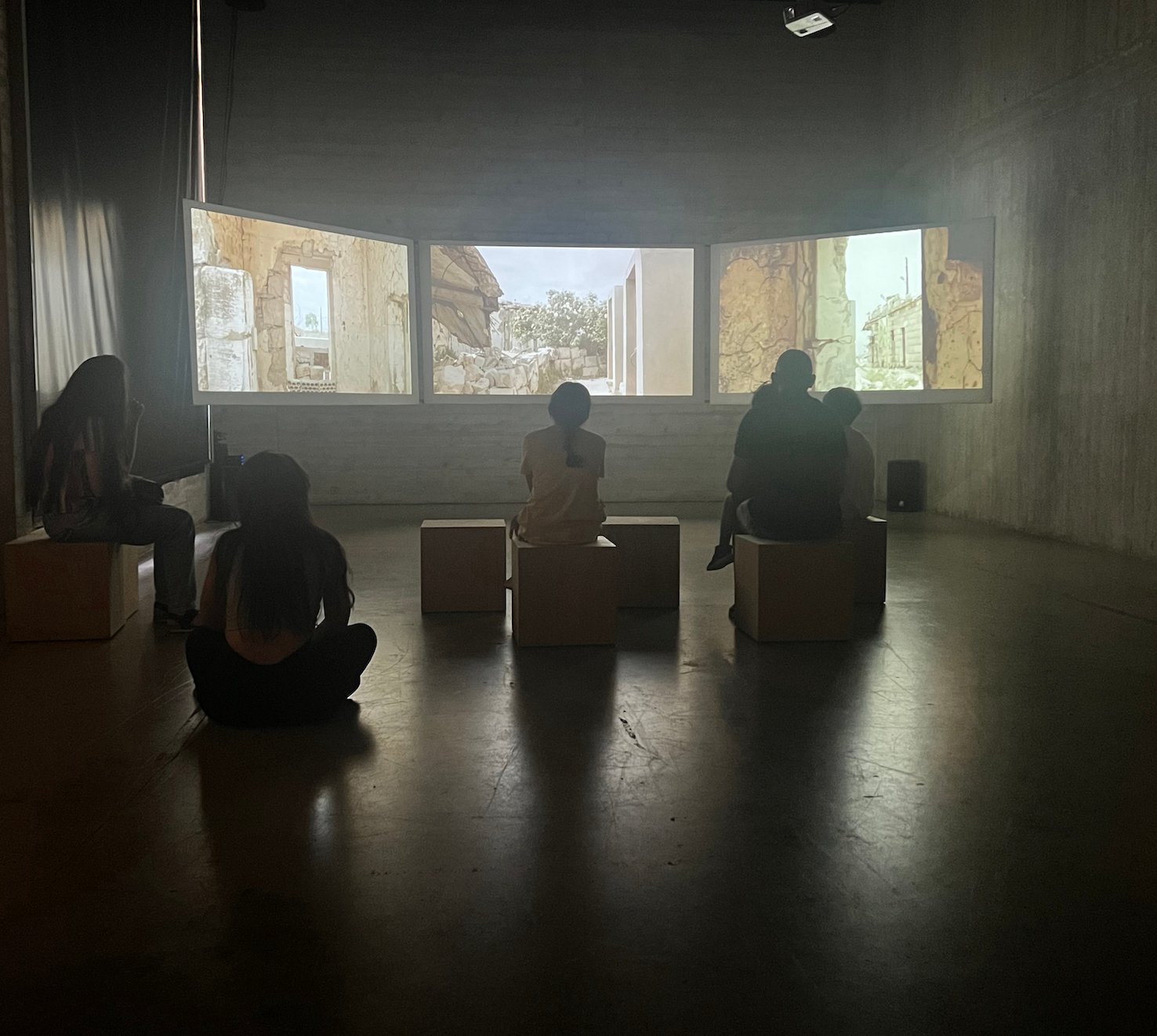 landscape: An exhibition view of “The Bunker, The Barracks and The Base.” (Courtesy of: Mina Image Centre)
landscape: An exhibition view of “The Bunker, The Barracks and The Base.” (Courtesy of: Mina Image Centre)
Contemporary wreckage
Faour is an architectural researcher, writer and filmmaker, with degrees from the American University of Beirut and the University of Toronto. Today she works between Beirut and Toronto. The work in her Mina show is not her first to muse over wrecked architecture.
She started on her UofT MA thesis project while Beirut, buckling beneath economic collapse and COVID lockdown, was grappling with the aftermath of the Aug. 4, 2020 port blast.
“I was looking at the impossibility of the situation and the heaviness of the research,” she recalls. “I didn't know what design could do here, [so] I told my thesis advisor I just want to tell the story.
“Writing and filming in parallel fed into each other. I was writing and I shot a bunch of footage. Then I wrote some more and then I went out and filmed some more.”
Faour’s thesis has since been adapted to essay form and published online as “Glass Politics: On Broken Windows in Beirut,” a reflection on the place of glass in Lebanon’s culture and political economy, which went on to win the prestigious Avery Review Essay Prize. Her footage, and strands of the essay text, became her first short film “Shafāfiyyāh.”
“There was a sort of power for me in image-making,” she says, “that I wanted to explore further.”
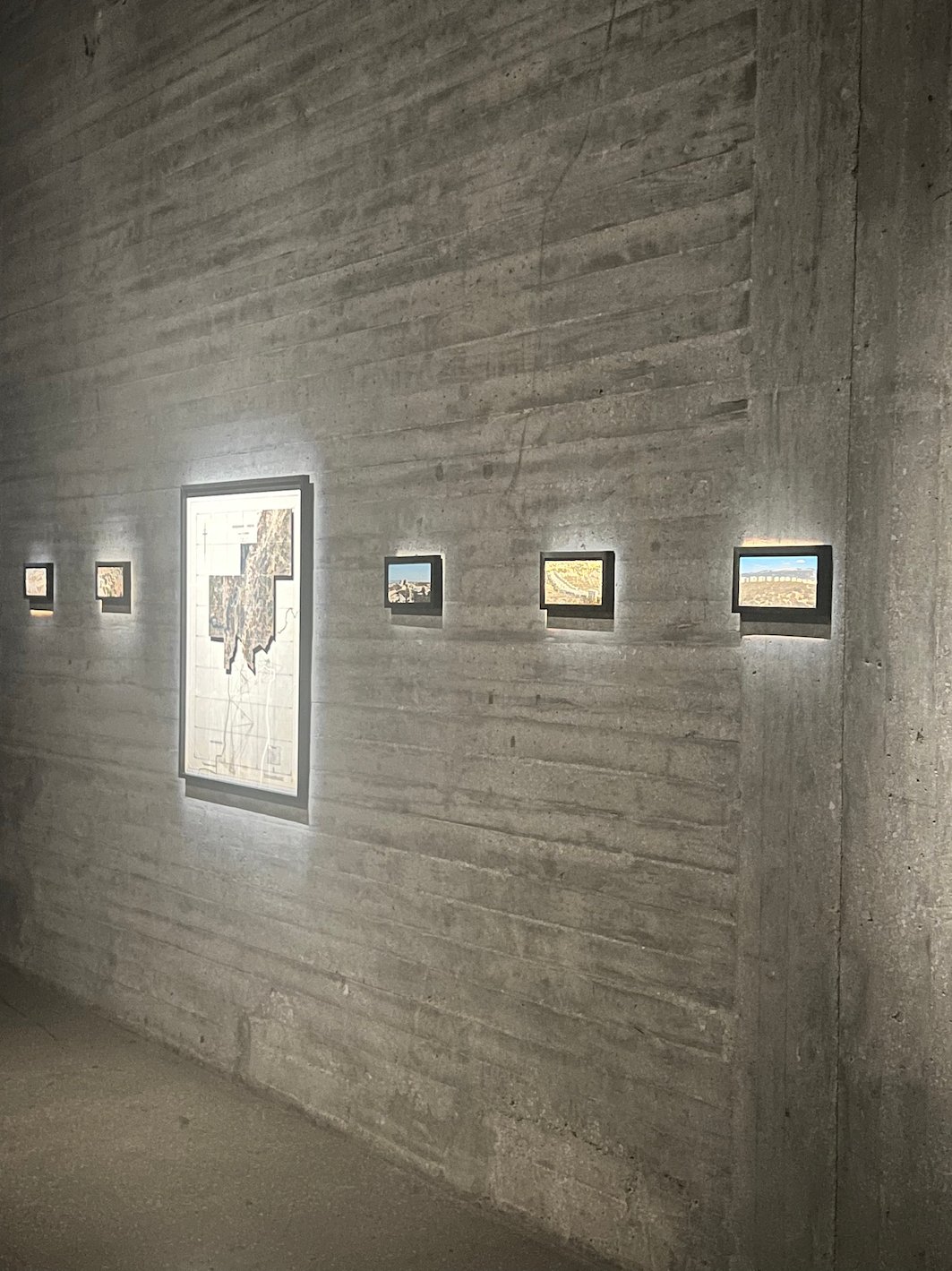 Faour’s show includes a collage superimposing a satellite photo of the Khiam region over an archival plan for Britain’s “Merdjayoun Scheme.” (Courtesy of: Mina Image Centre)
Faour’s show includes a collage superimposing a satellite photo of the Khiam region over an archival plan for Britain’s “Merdjayoun Scheme.” (Courtesy of: Mina Image Centre)
Modern ruins, other wars
Disused architecture has fed some significant contemporary art in Lebanon. While antique Greco-Roman remains dotting the eastern Mediterranean landscape were important to Orientalist art and the region’s early photography, derelict 20th-century architecture has been more provocative to current sensibilities — perhaps because it speaks to living memory and the incongruities of recent history.
Vestiges of modernism remain compelling. The unfinished structures Oscar Niemeyer designed for the Tripoli International Fairground and “the Dome,” the corn kernel-shaped fragment of Beirut’s pre-Civil War city center complex, have both hosted contemporary art exhibitions and sometimes been made part of the art itself. Some years ago, artist Rayyane Tabet created a diverse assortment of pieces inspired by the residues of TAPLine, the company managing an oil infrastructure network that formerly brought Saudi crude to its terminus in Zahrani, which still stands.
Faour’s project is interested in the afterlives of Khiam’s WWII-era architecture.
Khiam has been a point of reference for Lebanese cultural production because Israel’s occupation regime (1982-2000) retooled the British barracks as a Lebanese-operated detention center, where infamy accrued over the years. It was because of this prison, in fact, that many non-Lebanese knew of Khiam’s existence.
It inspired Joana Hadjithomas and Khalil Joreige to make their film “Khiam,” based on interviews with some of its former detainees — a work they updated in 2007, after the Israeli military destroyed much of the facility’s remains during the 2006 war. Khiam’s most famous survivor, Suha Bishara, has inspired any number of theater and film works.
These earlier works serve as studies of carceral brutality, what it suggests about the human condition and how political movements can instrumentalize institutional abuse. Faour’s study reintegrates the former barracks within its original architectural ensemble, and a wider history.
“My work deals with the political entanglements of architecture and how you can read politics and history through space in a way that you can't through [official accounts] — especially obstructed history that is not necessarily written or recorded somewhere. You have to look at the experience of the spaces, the stories around them, in order to uncover that.”
Her project grows out of the experience of studying Lebanese history after returning to the country at the age of 11.
“In the history books, you're taught that we gained our independence in 1943, and that’s it,” she smiles. “I was interested in how to dig into that history, and how to have more nuanced conversations around it, engaging multiple people from different backgrounds.
“The pocket of history that the project taps into is not something a lot of people are aware of,” she adds. “I feel like the barracks site would be a place many people would know about, but I’ve mentioned it to a lot of Lebanese people, who grew up here, and they'd be like, ‘I've never heard of it.’”
She laughs. “It’s kind of crazy.”
If the barracks’ afterlife is the most infamous of the ensemble, that of the hospital bunker is the most ironic.
“It was built under an olive grove, with very minimal visibility from above,” Faour says. “Based on the photos I've seen, what was left of it after it was abandoned was just skylights with holes in the ground, overwhelmed by the landscape above.”
Khiam municipality renovated the bunker into a museum between 2004 and 2005. After that, it was no longer invisible.
“They wanted to turn it into a fairground where people could gather. They installed huge interlocking pavements and seating areas and fountains. The museum had a cafeteria, a library, office spaces. It only operated for a few months, I think.”
The cone-shaped feature Faour had first noticed while driving with her gran, vaguely resembling an elaborate ventilation duct, is actually an art installation by one of her AUB instructors, called “The Scarecrow.”
“I don't remember the exact intentions of work,” she says, “but it somehow wanted to scare off Israeli warplanes, which was very ironic ... [since the bunker] had become like a bullseye from above.”
“If I’m not wrong, Khiam was bombed over 200 times in 2006. Some people say there was talk that maybe [the museum] was being used as a weapons bunker. But the Israelis didn't really need an excuse.”
“The Bunker, The Barracks, and The Base” is up at Mina Image Centre through Oct. 25. Faour will stage a lecture performance at Mina Tuesday, Oct. 24 at 8 p.m.